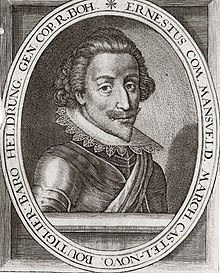Ernst von Mansfeld
Graf von Mansfeld | |
|---|---|
 | |
| Born | c. 1580 |
| Died | 29 November 1626 (aged c. 46) |
| Years active | 1595–1626 |
| Parent |
|
Peter Ernst, Graf von Mansfeld (
Biography
Ernst was an
He gained his earliest military experiences during the Long War in Hungary, where his elder half-brother Charles (1543–1595), also a soldier of renown, held a high command in the imperial army. While his brother succumbed to an epidemic within short time, young Ernst stayed at the theatre of war for several years. In the War of the Jülich Succession he served under Archduke Leopold V of Austria, until that prince's ingratitude, real or fancied, drove him into the arms of the enemies of the House of Habsburg. Although he remained a Roman Catholic, from about 1610 he openly allied himself with the Protestant princes, and during the earlier part of the Thirty Years' War he was one of their foremost champions.[2]
He was despatched by
From the Upper Palatinate, he passed into the
About 1624 he paid three visits to
Notes
- ^ Regarding personal names: Until 1919, Graf was a title, translated as Count, not a first or middle name. The female form is Gräfin. In Germany, it has formed part of family names since 1919.
- ^ a b c d e Chisholm 1911, p. 599.
- ^ https://www.academia.edu/38288379/Mansfeldschlass_Un_ch%C3%A2teau_disparu_1604_2018
- ^ Chisholm 1911, pp. 599–600.
References
- This article incorporates text from a publication now in the public domain: Chisholm, Hugh, ed. (1911). "Mansfeld, Ernst". Encyclopædia Britannica. Vol. 17 (11th ed.). Cambridge University Press. pp. 599–600. Endnotes:
- F. Stieve, Ernst von Mansfeld (Munich, 1890)
- R. Reuss, Graf Ernst von Mansfeld im böhmischen Kriege (Brunswick, 1865)
- A. C. de Villermont, Ernest de Mansfeldt (Brussels, 1866)
- L. Graf Uetterodt zu Scharfenberg, Ernst Graf zu Mansfeld (Gotha; 1867)
- J. Grossmann, Des Grafen Ernst von Mansfeld letzte Pläne und Thaten (Breslau, 1870)
- E. Fischer, Des Mansfelders Tod (Berlin, 1878)
- S. R. Gardiner, History of England, vols. iv. and v. (1901);
- J. L. Motley, Life and Death of John of Barneveld (ed. 1904; vol. ii)
Further reading
- Ernst von Mansfeld - notification (also in English) concerning the latest biography about the mercenary leader (published in September 2010)
- Book review and summary (in English) of the German biography mentioned before
